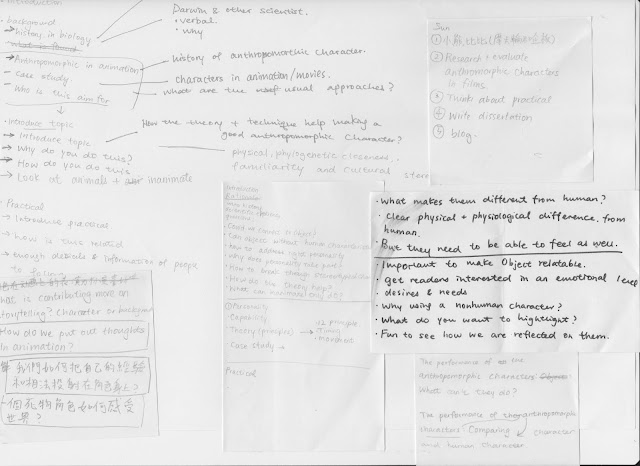I was at the stage developing ideas for my practical work. I did not feel good about it because I was hoping to get more reading and writing done before actually planning for the practical. This way the practical could be more suitable and could be given more consideration. Anyway I showed these drawing I did over the weekend to the class, saying that I wanted to make three character designs with the emotions symbols inspired by the flour sack test and produce short clips of animation showing these actions. I am doing this practical because I felt like drawing was the best answer towards achieving anthropomorphism. The feedback I got from Annabeth was that I should not be doing these drawing focus practical, but tackling theoretically instead. It might be good to compare objects that are given significant facial expressions or arms or legs with objects that are honestly presented without giving human features. Create a scenario, and analyse the selection of objects.
Some other people suggest the word simulacra, meaning that something that looks like or represents something else. For example seeing cloud like sheep or seeing faces on a tree truck. If I try to avoid giving human features to the objects, this might be something I could look into. They also suggested me to look at the Toon shoe in Who framed Roger Rabbit. How the shoe shows a lot of personality and look at the way it is designed.
The pixar lamp that I am always recommended.
Charlie Chaplin's performance techniques apply on inanimate character
After the presentation, I was extremely stressed and depressed. Partly because I feel like the work I have done is wasted, partly because of the time we got left. The most importantly, I am disappointed with myself that I do not know how to look at the topic with depth. It feels like I am touching the surface only so I could not reproduce anything fascinating like everyone does. What is in my essay now are talking about how to give a character personality which is something that everyone could easily know by simply flipping animation book. I feel like my dissertation now is lack of a clear direction. It is not anthropomorphism focus.
I could not find anyone to talk to face to face because Annabeth was busy and Mike was not in today. So I talked to my boyfriend Tony who always has good perspective looking at thing. After explaining my situation with him. He pointed out that I might be misunderstanding the word anthropomorphism. I realised that this word is not only talking about the humanising animals or object but also the concept of putting our emotion on them. So far I only focus on the practical side of it and never really look at anthropomorphism in other perspective, that might explain why I could not find any theory that could apply directly on creating humanised characters practically because anthropomorphism is very theoretically based.
We also talked about the structure and reconsider about the questions again since they are very shallow. Instead of just saying why personality takes a great part in anthropomorphic characters, I think looking at how do they generate empathy with the audience? Considering anthropomorphism could be in many forms in characters: Inanimate Object. Not humanised at all. examples like Wilson the volleyball in Cast away; the House in Up; the red ballon. Why do we think they have a personality even though they are just what they are? Also Why do we like using anthropomorphic characters? are there something special about them that animated actors can not do? What are the limitation of anthropomorphising? At this point, practical analyse is minor factors if my essay is going in this direction. I would like to have a long conversation with Mike or Annabeth tomorrow. The time management is still alright since no big changes are made in the essay so far, the only thing I need to do in hurry is to read more useful resources and texts in order to support my thoughts.






















